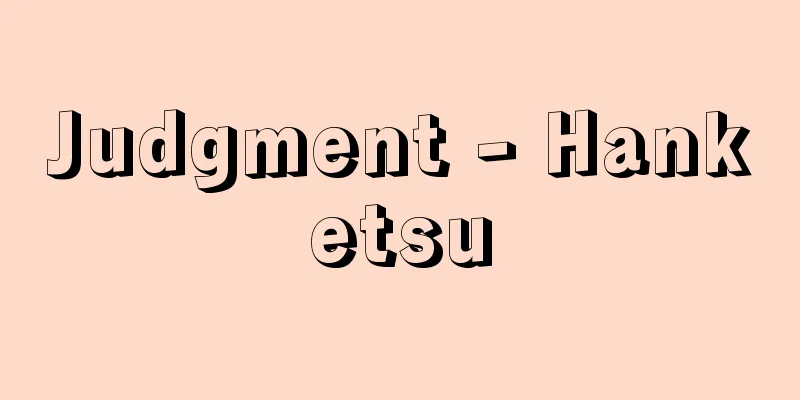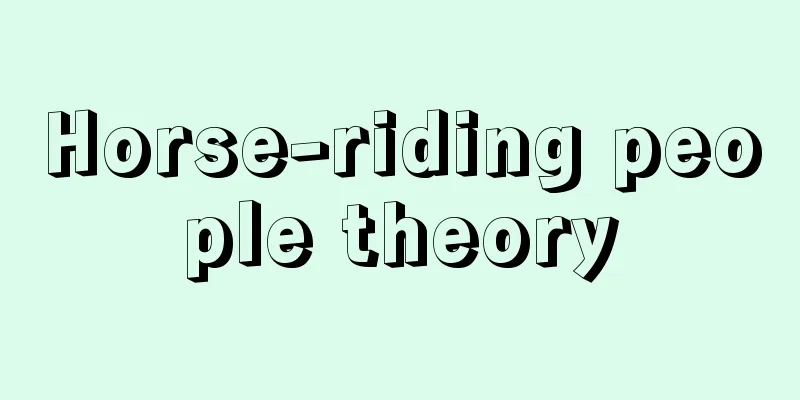Judgment - Hanketsu

|
It is one of the decisions made by a court that indicates the outcome of a trial, and is on par with a decision or order. [Takeyoshi Uchida and Tetsuo Kato] Civil lawsuit judgmentIt is a trial in which the court prepares the original judgment in accordance with the legal formalities, based on oral argument as a rule, and notifies the parties in a strict manner by handing it down in open court (Civil Procedure Act, Articles 252 and 253, Civil Procedure Rules, Article 157). In normal lawsuits, the matters that must be decided in a judgment are the legality of the lawsuit or appeal, the validity of the claims of rights that are the subject of the lawsuit, and interlocutory judgment matters. In addition, judgments may be made in provisional attachment, provisional disposition procedures, and public notice procedures. Since judgments must be based on oral argument as a rule, the court that issues the judgment must be composed of judges who participated in the oral argument (Civil Procedure Act, Article 249, Paragraph 1). However, there are cases in which a judgment can be made without oral argument (Civil Procedure Act, Articles 78, 140, 290, and 319). After rendering the judgment, the presiding judge delivers the original of the judgment to the clerk (Civil Procedure Rules, Article 158), who prepares a certified copy and serves it on the parties within two weeks (Civil Procedure Code, Article 255, Paragraph 1; Civil Procedure Rules, Article 159, Paragraph 1). If the judge finds that the judgment violates laws and regulations, he may render a revised judgment within one week after rendering (Civil Procedure Code, Article 256), and if the judgment contains a miscalculation, clerical error, or other similar obvious error, he may correct the judgment at any time (Civil Procedure Code, Article 257, Paragraph 1). If the court omits to make a judgment on part of the claim, it should render an additional judgment (Civil Procedure Code, Article 258). [Takeyoshi Uchida and Tetsuo Kato] kindsJudgments can be classified from various perspectives. First, they are divided into final judgments, which conclude the case at the relevant level, and interlocutory judgments, which are made to prepare for the making of a final judgment and to organize the trial. Final judgments include full judgments, partial judgments, and additional judgments. In the case of a lawsuit or appeal, the legality and sufficient grounds for the judgment are judged, and they are divided into a suit judgment and a judgment on the merits, respectively. In the case where the plaintiff wins the suit, the judgment on the merits is classified into a judgment for payment, a declaratory judgment, and a formative judgment (founding judgment) depending on the content. In addition, in terms of the procedure and subject, trials are classified into judgments, decisions, and orders. In terms of the subject, judgments and decisions are decisions made by the court, while orders are decisions made by the presiding judge, the commissioned judge, and the commissioned judge based on their qualifications. In terms of procedure, judgments are distinguished from decisions and orders, which are the most thorough and are made based on simpler procedures, as mentioned above. In the case of decisions and orders, holding oral argument is optional (Article 87, Paragraph 1, proviso of the same Act), and they take effect if they are notified in a manner deemed appropriate (Article 119 of the same Act). [Takeyoshi Uchida and Tetsuo Kato] Criminal JudgmentsIt is a type of trial recognized by law. In cases of seriousness, a judgment is made, in cases of the next most seriousness, a decision is made, and in cases of even less seriousness, an order is made. A judgment must be made based on oral argument, except in cases where there are special provisions (Criminal Procedure Law, Article 43, Paragraph 1). In addition, a judgment must always include reasons. In addition, an assistant judge cannot make a judgment alone (Criminal Procedure Law, Article 45). There are two ways to appeal against a judgment of the first instance: an appeal to the Supreme Court and an appeal to the Supreme Court. The types of judgments in a first instance trial are (1) a judgment of incompetence, (2) a judgment of dismissal of the charges, (3) a judgment of acquittal, (4) a judgment of acquittal, and (5) a judgment of guilty. Of these, a judgment of acquittal is handed down when the accused is not found guilty or when there is no proof of a crime (Criminal Procedure Law, Article 336). There are two types of guilty judgments: a judgment of sentence and a judgment of exemption from punishment. When the crime of the accused is proven, a sentence must be handed down in a judgment, except in cases where the sentence should be waived (Article 333, Paragraph 1 of the same law). In cases of suspension of execution of a sentence or provisional payment, this must be handed down in a judgment at the same time as the sentence is pronounced. The same applies to cases where a person is placed on probation. When the crime of the accused is proven, but the sentence is waived, a sentence to that effect must be handed down in a judgment. There are also judgments in appellate courts and supreme courts that overturn the original judgment, judgments that dismiss the appeal, judgments that dismiss the appeal, judgments that dismiss the extraordinary appeal, and judgments that overturn. [Ichiro Uchida] [References] | | | | | | | | | | | | | | | | | |Source: Shogakukan Encyclopedia Nipponica About Encyclopedia Nipponica Information | Legend |
|
裁判所が裁判の結果を示す判断の一つで、決定、命令と並ぶもの。 [内田武吉・加藤哲夫] 民事訴訟における判決裁判所が、原則として口頭弁論に基づいて、法定の方式に従った判決原本を作成し、公開の法廷で言い渡すという厳格な方法により当事者に告知する裁判をいう(民事訴訟法252条、253条、民事訴訟規則157条)。判決で裁判しなければならない事項は、通常の訴訟では、訴えや上訴の適法性、訴訟物である権利主張の当否、中間判決事項などである。そのほかに仮差押え、仮処分手続、公示催告手続において判決がなされることがある。判決は原則として口頭弁論に基づくことを必要とするから、判決する裁判所はその口頭弁論に関与した裁判官によって構成されなければならない(民事訴訟法249条1項)。ただし、口頭弁論を経ないで判決できる場合(同法78条、140条、290条、319条)がある。 判決の言渡し後、裁判長は判決原本を書記官に交付し(民事訴訟規則158条)、書記官はその正本を作成して2週間内に当事者に送達する(民事訴訟法255条1項、民事訴訟規則159条1項)。なお、判決が法令に違反したことを発見したときは、言渡し後1週間内に限り変更の判決をすることができるし(民事訴訟法256条)、判決に計算違い、誤記、その他これに類する明白な誤りがあるときは、いつでも判決の更正ができる(同法257条1項)。また、裁判所が請求の一部について判断を脱漏したときは、追加判決をすべきである(同法258条)。 [内田武吉・加藤哲夫] 種類判決は種々な見地から分類することができる。まず、事件を当該審級において完結する終局判決と、終局判決をなす準備をし、審判を整序する目的でなされる中間判決とに区別される。終局判決には、全部判決、一部判決、追加判決などがある。訴えまたは上訴に対して、その適法性と理由具備性の判断につき、それぞれ訴訟判決と本案判決とに分けられる。本案判決は原告勝訴の場合に、その内容によって給付判決、確認判決、形成判決(創設判決)に分類される。また、その手続および主体からみた形式的分類として、裁判には、判決、決定、命令がある。それらを主体の面からみると、判決・決定は裁判所のなす裁判であり、命令は裁判長・受命裁判官・受託裁判官がその資格に基づいてなす裁判である。手続の面からみると、判決が前記のように、もっともていねいであって、より簡易な手続に基づいてなされる決定・命令と区別される。決定・命令の場合は、口頭弁論を開くかどうかは任意的であり(同法87条1項但書)、相当と認める方法で告知すれば、その効力を生ずる(同法119条)。 [内田武吉・加藤哲夫] 刑事訴訟における判決法律の認める裁判の一種をいい、事態の重大なものは判決をもってし、これに次ぐものは決定をもってし、さらに軽微なものは、命令をもってする。判決は、特別の定めのある場合を除いては、口頭弁論に基づいてこれをしなければならない(刑事訴訟法43条1項)。また判決にはかならず理由を付さなければならない。なお、判決は判事補が1人でこれをすることはできない(同法45条)。第一審の判決に対する不服申立ての方法としては、控訴、上告がある。第一審公判の判決の種類としては、(1)管轄違いの判決、(2)公訴棄却の判決、(3)免訴の判決、(4)無罪の判決、(5)有罪の判決がある。このうち、無罪の判決は、被告事件が罪とならないとき、または被告事件について犯罪の証明がないときにこれを言い渡す(同法336条)。有罪の判決には、刑の言渡しの判決と刑の免除の判決の2種類がある。被告事件について犯罪の証明があったときは、刑を免除すべき場合を除いては、判決で刑の言渡しをしなければならない(同法333条1項)。刑の執行猶予、仮納付の裁判は、刑の言渡しと同時に、判決でこれを言い渡さなければならない。保護観察に付する場合も同様である。被告事件について犯罪の証明はあったが、刑を免除するときは、判決でその旨の言渡しをしなければならない。控訴審、上告審での原判決破棄の判決、控訴棄却の判決、上告棄却の判決、非常上告での棄却の判決、破棄の判決などもある。 [内田一郎] [参照項目] | | | | | | | | | | | | | | | | | |出典 小学館 日本大百科全書(ニッポニカ)日本大百科全書(ニッポニカ)について 情報 | 凡例 |
<<: Pan-Germanism - Pan-Germanism
Recommend
National Museum of Ethnology
It is a research institute that constitutes the I...
Caribbean Current
…The temperature is about 25-28°C in the south of...
Willem Cornelius Schouten
?-1625 Dutch navigator. In 1616, he discovered a s...
Manchu - Manshugo (English spelling) Manchu
The language of the Manchu people who founded the...
Kim Jong-pil
A South Korean soldier and politician. Born in Bu...
Colorimetry
Measuring the quantities used to express color. Th...
Körner, Theodor
Born: April 24, 1873, Komárno, Hungary [died] Janu...
long tailed skua
...They breed in the northern part of the Norther...
Raccoon dog (tanuki) - Raccoon dog
A mammal of the Canidae family in the carnivora or...
Naka [town] - Naka
A former town in Taka District, central Hyogo Pref...
Leda - Leda (English spelling)
A woman who appears in Greek mythology. Daughter ...
Moment of force - Moment of force
…Couples do not affect the movement of the center...
Udatsuya - Udatsuya
…By the way, on the other hand, udatsu is also a ...
Tulipa gesneriana (English spelling)
…[Hiroshi Aramata]. … *Some of the terminology th...
Song Jin-u (English spelling)
[Born] Yi Tae King 27 (1890).5.8. Damyang, Jeollan...









![Dai [Hot Spring] - Dai](/upload/images/67cc147edefd0.webp)